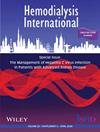The Utility of Vascular Access Intervention via the Distal Radial Artery Approach in Hemodialysis Patients With Vascular Dysfunction
Abstract
Background
Although case reports exist on vascular access intervention through the distal radial artery approach, there is a dearth of clinical studies reporting its safety and clinical outcomes. This study aimed to investigate the safety and long-term outcomes of vascular access intervention utilizing the distal radial artery approach.
Methods
Patients who underwent forearm arteriovenous fistula vascular access intervention at our hospital were divided into two groups: The distal radial artery approach (DRA group, N = 46) and the outflow vein approach (Vein group, N = 122). Patient characteristics, procedure results (procedure success rate, contrast medium dose, fluoroscopy dose), and one-year primary patency rates were compared between the two groups.
Findings
The procedure success rate was 100% in both groups. The DRA group demonstrated significantly lower contrast medium dose, fluoroscopy dose, and fluoroscopy time compared to the Vein group. No bleeding complications, arterial occlusion, or steal syndrome occurred in the DRA group. There was no significant difference in the one-year primary patency rate between the two groups.
Discussion
Vascular access intervention utilizing the distal radial artery approach offers benefits in reducing contrast medium and fluoroscopy dose compared to the outflow vein approach. Moreover, it demonstrates acceptable safety and patency rates.

 求助内容:
求助内容: 应助结果提醒方式:
应助结果提醒方式:


